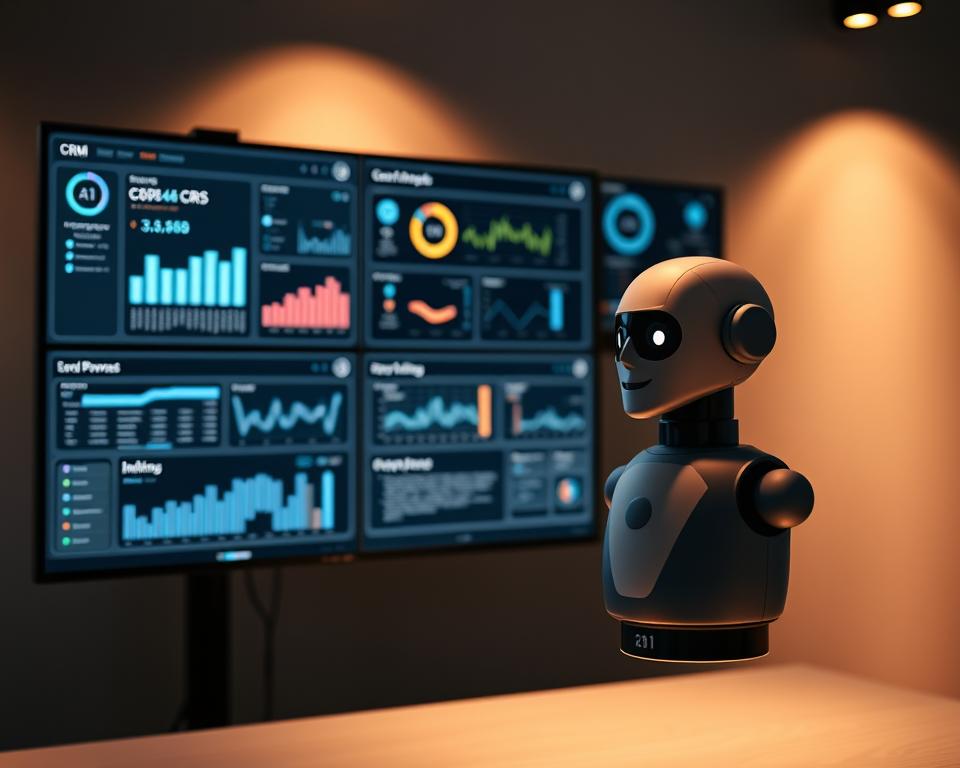Building a smart AI-powered CRM system is key for businesses wanting to manage customers better and grow. It uses artificial intelligence to offer a data-driven solution. This improves how customers are interacted with and boosts sales.
AI-powered CRM systems can analyze lots of data. They can predict what customers will do next, make marketing more personal, and do routine tasks automatically. This makes them essential for today’s businesses.
Using AI-powered CRM can greatly improve how companies manage customers. This leads to more business growth. For example, AI-powered customer support can offer better and more personalized help. This makes customers happier and more loyal.
Table of Contents
Introduction to AI-Powered CRM
AI-powered CRM systems are crucial for businesses wanting to better manage customers and grow. They use artificial intelligence to look at lots of data. This gives insights that help make better business decisions and improve sales.
Key Takeaways
- AI-powered CRM systems can analyze vast amounts of data to predict customer behavior and personalize marketing efforts.
- These systems can automate routine tasks, improving efficiency and reducing costs.
- AI-powered CRM can enhance customer interactions, leading to increased customer satisfaction and loyalty.
- Businesses can experience significant improvements in customer management and business growth by leveraging AI-powered CRM.
- AI-powered CRM systems can provide valuable insights that inform business decisions and improve sales performance.
- By streamlining customer management, AI-powered CRM systems can help businesses drive growth and stay competitive in the market.
Understanding AI-Powered CRM Systems
To create a smart AI-powered CRM system, it’s key to know the difference between old CRM systems and new AI ones. Old CRM systems just store customer data and track interactions. But, AI-powered CRM systems use smart algorithms to analyze data, guess what will happen next, and give useful insights.
Adding AI to CRM systems brings many advantages. It makes customer service better, helps predict sales, and makes operations more efficient. An AI-powered CRM system has three main parts: data analysis, smart models, and automation tools. These parts help give a full picture of how customers interact and let businesses make smart choices.
Some important features of AI-powered CRM systems include:
- Predictive analytics to guess what customers will do next
- Personalized marketing campaigns to keep customers engaged
- Automated sales forecasting to boost sales
- Real-time customer insights for quick customer service
These features help businesses stay ahead and offer better customer service. More and more companies are using AI in their CRM systems. As technology gets better, we’ll see even more cool uses of AI in CRM systems.
The parts of an AI-powered CRM system work together well. They give a full view of customer interactions and help businesses make smart choices. Knowing the benefits and features of AI-powered CRM systems helps businesses decide how to use this tech to get better at what they do and serve their customers better.
Essential Prerequisites for Building a Smart CRM
Before starting a smart CRM project, it’s key to know the must-haves. You need to outline business requirements like making decisions with data, personalizing customer experiences, and automating processes. It’s also important to understand how you manage customers now and where you can get better.
Knowing what data you have and what you need for an AI CRM is crucial. Important things to think about include:
- Defining the scope of the CRM project
- Identifying the required data sources and integration points
- Assessing the existing technology infrastructure and potential gaps
By looking at these prerequisites and business requirements carefully, companies can set up a strong smart CRM system. This system will meet their specific needs and help them grow.
Planning Your AI-Powered CRM Architecture
Building a smart AI-powered CRM system starts with careful planning. This phase involves several key steps to ensure the system meets your business needs. It must also grow with your company.
First, you need to analyze what your system requires. This means looking at the CRM architecture and its parts. You must figure out how they will help your business run smoothly.
Next, choose the right technology stack for AI and machine learning. Pick the best programming languages, frameworks, and tools. A good technology stack helps your system handle lots of customer data and give insights in real-time.
System Requirements Analysis
- Identify the necessary features and functionalities
- Evaluate the CRM architecture and its components
- Determine the system’s scalability and performance requirements
Technology Stack Selection
Choosing the right tech stack is crucial. It should handle lots of customer data and offer insights quickly. The system requirements will help pick the best tech stack for your business.
Data Management Framework
A strong data management framework is key for handling lots of customer data. This includes designing a database schema, data warehousing, and data governance. The CRM architecture should give real-time insights and support your business decisions.
Selecting the Right AI Technologies
Building a smart AI-powered CRM system starts with picking the right AI technologies. You need to choose the best machine learning algorithms to analyze customer data and predict their actions. AI software development companies can help integrate these into your CRM.
Natural language processing is also key. It powers customer service chatbots and helps understand customer feelings. By using these AI tools, businesses can make their CRM systems better and offer better service. Important things to think about when picking AI technologies include:
- Scalability and flexibility
- Data quality and integration
- Security and compliance
By carefully looking at these points and picking the right AI technologies, businesses can build a smart CRM system. This system can help grow and succeed.
Data Collection and Processing Framework
Creating a strong data collection and processing framework is key for an AI-powered CRM system. It involves finding and combining different data sources. These include customer interactions, transactional data, and social media feeds. This helps with effective data collection and data processing.
The framework must have real-time capabilities. This means it can give quick insights and answers to customer interactions. This boosts the customer experience. Advanced technologies and tools help with real-time data processing and analysis.
- Identifying and integrating relevant data sources
- Ensuring data quality through cleaning and preparation
- Implementing real-time processing capabilities for immediate insights and responses
By following these steps and using advanced technologies, businesses can build a solid framework. This framework supports their AI-powered CRM system. It also improves customer experiences through effective data collection and data processing.
Implementing Machine Learning Models
Machine learning is key to making a smart AI-powered CRM system. It helps businesses understand past customer data and guess future customer behavior. This way, they can talk to customers in a more personal way and keep them coming back.
Predictive models spot important customers, predict when they might leave, and find new sales chances. These models get better with time, thanks to ongoing training. Some big pluses of using machine learning models are:
- Improved customer segmentation
- Enhanced personalization
- Increased customer retention
- Better sales forecasting
Using predictive models and machine learning helps businesses know what their customers want. This leads to more sales and keeps them ahead of the competition.
Building Customer Intelligence Features
To really understand what customers want, businesses need to build customer intelligence features. They do this by looking at customer data to spot patterns and trends. This helps them target their marketing better and make customers happier. By using predictive analytics, companies can guess how customers will act and make smart choices.
Some important parts of creating customer intelligence features are:
- Collecting and analyzing customer data to find patterns and trends
- Adding predictive analytics to guess how customers will behave
- Using sentiment analysis tools to see what customers feel and think
With these features, businesses can get to know their customers better. They can then offer personalized experiences that keep customers coming back. 
How to Build a Smart AI-Powered CRM System: Step-by-Step Guide
To build a smart AI-powered CRM system, start with core system development. This means designing the database, user interface, and other key parts. A solid core system is crucial for managing data well and automating workflows.
A step-by-step guide must include AI module integration. This step adds machine learning, natural language processing, and more AI to boost the system. With AI, businesses get tools like predictive analytics and automated decisions.
Here are important steps for core system development and AI module integration:
- Define system requirements and specifications
- Design a scalable and flexible architecture
- Develop a user-friendly interface
- Integrate AI modules for advanced features
- Test and validate the system for optimal performance
By following this step-by-step guide and focusing on core system development and AI module integration, businesses can build a smart AI-powered CRM. This system will help grow the business, improve customer satisfaction, and increase efficiency.
Security and Privacy Considerations
Building a smart AI-powered CRM system means keeping customer data safe. It’s important to use strong data protection like encryption and access controls. This stops unauthorized access. Companies must also follow data privacy laws like GDPR and CCPA to avoid legal and reputation problems.
Having a good access control system is key. This includes multi-factor authentication and role-based access control. It makes sure only the right people see customer data. Also, keeping systems and software up to date helps fight off cyber threats.
Putting security and privacy first helps keep customer trust. For more on making a secure CRM, check out nextbigtechnology.com. They share the latest in CRM development.
Here are some ways to protect data:
- Use encryption for data at rest and in transit
- Do regular security audits and risk checks
- Train employees on security and privacy best practices
User Interface and Experience Design
Creating a user-friendly interface is key for a smart AI-powered CRM system’s success. A good user interface makes using the system easier, cutting down on learning time and boosting productivity. It’s important to think about what users need and want when designing a smart AI-powered CRM system.
Dashboard creation is a big part of the user experience. A customizable dashboard lets users focus on what matters most to them. This can be done with tools like data visualization and reporting.
- Keep it simple and easy to understand
- Use clear and straightforward language
- Make sure it’s easy to navigate and accessible
By following these tips and considering what users need, you can make a smart AI-powered CRM system. It will have a user interface that’s both useful and easy to use. This will lead to a better user experience and help with dashboard creation.
Integration with Existing Business Systems
Building a smart AI-powered CRM system means thinking about system integration with other business systems. This includes marketing automation and customer service platforms. It helps create a single view of the customer and makes operations smoother. API integration is key here, allowing data to flow easily between systems.
Integrating with current business systems lets companies use what they already have. It cuts down on data silos and boosts overall efficiency. This is done through API integration, which shares data in real-time. Some benefits include:
- Improved customer experience
- Increased operational efficiency
- Enhanced data accuracy
Getting system integration right is vital for a smart AI-powered CRM system. By linking with existing business systems and using API integration, companies can build a unified and efficient system. This system drives business growth and makes customers happier.
Performance Optimization and Scaling
As the smart AI-powered CRM system handles more traffic and data, performance optimization is key. It ensures smooth operations. This means always watching the system to find and fix problems quickly.
Load balancing is also important. It spreads the work across servers to avoid overload. This lets the system grow without slowing down.
- Regularly update and maintain software and hardware resources
- Implement efficient data management and processing frameworks
- Monitor system performance and adjust settings as needed
By focusing on these areas, businesses can make their smart AI-powered CRM system work better. This leads to growth and success.
| Strategy | Benefits |
|---|---|
| Regular Updates | Improved Security, Enhanced Performance |
| Efficient Data Management | Reduced Costs, Increased Productivity |
| System Monitoring | Proactive Issue Detection, Minimized Downtime |
Maintenance and Updates Strategy
A good maintenance and updates plan is key for a smart AI-powered CRM system’s success. It means regular software updates, security fixes, and performance boosts. This keeps the system up-to-date and safe. By focusing on maintenance and updates, companies can keep their investment valuable and useful.
It’s important to have backup and recovery plans. This helps avoid data loss and system downtime. A strong data management system includes regular backups, data checks, and disaster recovery plans. For more on data management, check out nextbigtechnology for the latest trends and features.
Some top tips for maintenance and updates are:
- Check system performance and security often
- Use a solid testing and validation process
- Offer ongoing training and support for users
By sticking to these tips and making maintenance and updates a priority, businesses can keep their AI-powered CRM system safe, efficient, and effective. This leads to business growth and success with a well-thought-out strategy.
Measuring ROI and System Effectiveness
To see if a smart AI-powered CRM system works, we need to check its return on investment (ROI) and how well it works. We set key performance indicators (KPIs) to see how it affects business. By looking at KPIs like customer happiness, sales growth, and keeping customers, we can see if it meets our goals.
When we measure ROI and system effectiveness, we look at a few important things:
- Revenue growth: How much more money the CRM system brings in
- Customer acquisition costs: What it costs to get new customers with the CRM system
- Customer retention rates: How many customers stay with us over time
- System usage: How often and how much people use the system
By looking at these, we get a full picture of our CRM system’s ROI and effectiveness. This helps us make smart choices, improve the system, and run our business better.
It’s key for businesses to check if their smart AI-powered CRM system is doing its job and giving a good return on investment. By watching and checking KPIs, we can make our CRM better and achieve long-term success.
Common Challenges and Solutions
Setting up a smart AI-powered CRM system can be tricky. Businesses might run into issues like bad data, hard integrations, and getting users to adopt it. To tackle these problems, it’s key to have solutions ready. This includes testing well, training users, and keeping an eye on how things are going.
Here are some best practices for using an AI-powered CRM system:
- Make a detailed plan for setting it up
- Keep training and helping users
- Always check and see how the system is doing
Knowing the common challenges and having solutions and best practices helps. This way, businesses can make the switch to an AI-powered CRM system smoothly. They can also get the most out of it.
Conclusion
As we wrap up this guide, it’s clear that AI will change customer management forever. By using AI, businesses can improve how they talk to customers. This includes better sales and service through smart tools and data.
The use of AI in CRM helps companies understand their customers better. They can meet customer needs and offer unique experiences. This builds loyalty and helps businesses grow.
By using AI in CRM, companies can work smarter and make customers happier. This opens doors to new ideas and success. Businesses that use AI now will be ready for the future.


















